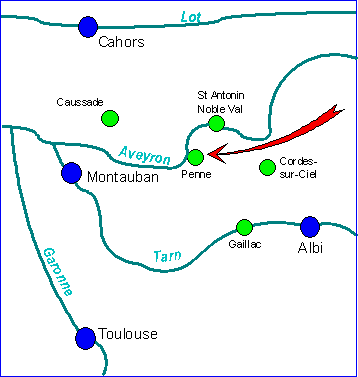 Home Page ] Home Page ]
Home Page ] Home Page ] 
Map of the region based on the main great rivers. Click on the places to jump to a short description.
Penne is one kilometre away. It is a wonderfully unspoilt medieval village complete with a ruined castle which from one angle teeters impossibly on the cliff above the village. The castle, having been neglected for many years, has now been made safe enough to open to the public. For more details, click here http://www.chateaudepenne.com
It is celtic in origin, was invaded by Romans, Franks and Sarracins. In the middle ages, it was a Cathar stronghold, and was assaulted during the Albigensian Crusades. It was occupied by the English during the 100 years war. The castle started to fall into ruin after being sacked by the protestants in 1586 during the wars of Religion.
There are two bar/restaurants serving simple menus with views over the valley (including back to Roussergues!). There is also a grocerís shop which sells a good range of everyday provisions including fresh bread as well as a Tourist Office which incorporates the post office.
About 3km out of Penne en route for the tiny village of St Paul de Mamiac is the tennis club with three good courts which are bookable at the Tourist Office in Penne.
Bruniquel lies about 10 km West of Penne on the river Aveyron, easily accessible from the D115 that follows the river. It is one of the featured "plus beaux villages de France". http://www.france-beautiful-villages.org/en/bruniquel . It is dominated by two castles one 12th and the other 15th century. They ended up being owned by two cousins, one catholic and one protestant, who were obviously on opposite sides during the wars of religion and hated each other. http://www.bruniquel.fr/
Bruniquel is also an important archeological site. Neanderthal constructions have been found 146,500 years old http://www.nature.com/nature/journal/v534/n7605/full/nature18291.html and there is plenty of evidence of early human occupation of caves in the vicinity.
A lovely Roman small town with a maze of narrow streets in the centre. The oldest town hall in France which is now a museum. Another Cathar town, it was taken by Simon de Montfort in 1212. It was occupied by the English in the hundred years war. Its most recent claim to fame is that it was used as the location for the filming of Charlotte Grey and The Hundred Step Journey starring Helen Mirren.
There's a good choice of restaurants and a supermarket. Very busy and fun market on Sundays . You can hire canoes here and spend a day boating down river towards Penne. Alternatively you can spend half a day and finish your trip at Cazals. Afterwards, a bus takes you back to St Antonin. Good fun, and there are just a few small rapids....
General website: http://www.saintantoninnobleval.com/Region.html and for the history, wikepedia has a good entry: http://en.wikipedia.org/wiki/Saint-Antonin-Noble-Val
A bit bigger but not huge. Caussade is renowned for its tradition of hat making. A really nice market on Monday, bigger and less touristy than St Antonin but not as big as Montauban. On the way, itís worth visiting the old chateau at Montricoux which is now a permanent art exhibition for Marcel Lenoir.
Capital town of the Tarn-et-Garonne department. Montauban was the prototype for the Bastide towns but has outgrown those origins. The Place Nationale, an arcaded square, was the ancient centre. It is now a pedestrianised area. The Musee Ingres is well worth a visit.
There are a number of large hypermarkets (the nearest to Penne is Leclerc in ZI nord). Huge partially covered market on Saturdays.
A very picturesque hilltop town (known fully as Cordes-sur-ciel). This is the jewel of the local bastide towns and, as such, attracts more tourists than is usual in the region. You are rewarded by the gruelling climb to the top of the old town with terrific views and many artisan shops and galleries.
Another pretty town, Gaillac is best known as the centre of a wine producing region. Both red and white distinctive wines are produced and, en route from our house to Gaillac, there are many wine producers to visit and sample their produce. The first is at Campagnac about 10kms away. Gaillac also has a big Leclerc hypermarket.
Cahors is the administrative capital of the Lot department and former capital of the Quercy region. Cahors managed to keep the English at bay during the hundred years war.
Capital of the Tarn department. The wonderful cathedral and Toulouse Lautrec museum are close to each other in the centre and are both well worth a visit. Albi is definitely the prettiest of the cities in the area.
An interesting personal article and links to photo of the stunning depiction of the last judgement in Albi cathedral is here http://www.dorsetbay.plus.com/travel/albi/albi01.htm